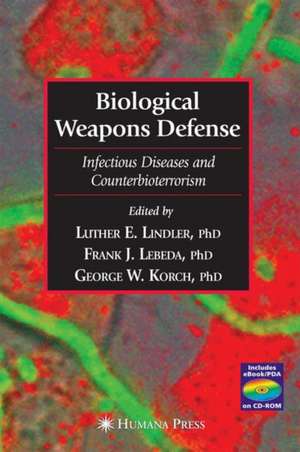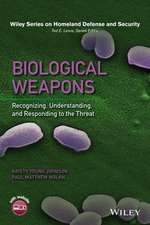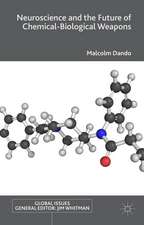Biological Weapons Defense: Infectious Disease and Counterbioterrorism: Infectious Disease
Editat de Luther E. Lindler, Frank J. Lebeda, George Korchen Limba Engleză Hardback – 10 dec 2004
Din seria Infectious Disease
- 5%
 Preț: 1435.28 lei
Preț: 1435.28 lei - 5%
 Preț: 1430.35 lei
Preț: 1430.35 lei - 18%
 Preț: 723.51 lei
Preț: 723.51 lei - 5%
 Preț: 801.13 lei
Preț: 801.13 lei - 5%
 Preț: 683.03 lei
Preț: 683.03 lei - 5%
 Preț: 1110.72 lei
Preț: 1110.72 lei - 5%
 Preț: 1094.25 lei
Preț: 1094.25 lei - 5%
 Preț: 1414.80 lei
Preț: 1414.80 lei - 5%
 Preț: 1101.37 lei
Preț: 1101.37 lei - 5%
 Preț: 790.88 lei
Preț: 790.88 lei - 5%
 Preț: 1027.15 lei
Preț: 1027.15 lei - 5%
 Preț: 1364.22 lei
Preț: 1364.22 lei - 18%
 Preț: 1280.72 lei
Preț: 1280.72 lei - 5%
 Preț: 2038.62 lei
Preț: 2038.62 lei - 18%
 Preț: 944.99 lei
Preț: 944.99 lei - 5%
 Preț: 1414.29 lei
Preț: 1414.29 lei - 5%
 Preț: 1113.99 lei
Preț: 1113.99 lei - 5%
 Preț: 1431.81 lei
Preț: 1431.81 lei - 5%
 Preț: 1121.69 lei
Preț: 1121.69 lei - 5%
 Preț: 1117.65 lei
Preț: 1117.65 lei - 5%
 Preț: 1612.30 lei
Preț: 1612.30 lei - 5%
 Preț: 723.05 lei
Preț: 723.05 lei - 18%
 Preț: 1253.42 lei
Preț: 1253.42 lei - 5%
 Preț: 1321.71 lei
Preț: 1321.71 lei - 5%
 Preț: 1427.62 lei
Preț: 1427.62 lei - 5%
 Preț: 725.04 lei
Preț: 725.04 lei - 5%
 Preț: 712.60 lei
Preț: 712.60 lei
Preț: 1846.28 lei
Preț vechi: 2251.56 lei
-18% Nou
Puncte Express: 2769
Preț estimativ în valută:
353.28€ • 384.96$ • 297.69£
353.28€ • 384.96$ • 297.69£
Carte tipărită la comandă
Livrare economică 23 aprilie-07 mai
Preluare comenzi: 021 569.72.76
Specificații
ISBN-13: 9781588291844
ISBN-10: 1588291847
Pagini: 598
Ilustrații: XXII, 598 p. 78 illus.
Dimensiuni: 178 x 254 x 43 mm
Greutate: 1.29 kg
Ediția:2005
Editura: Humana Press Inc.
Colecția Humana
Seria Infectious Disease
Locul publicării:Totowa, NJ, United States
ISBN-10: 1588291847
Pagini: 598
Ilustrații: XXII, 598 p. 78 illus.
Dimensiuni: 178 x 254 x 43 mm
Greutate: 1.29 kg
Ediția:2005
Editura: Humana Press Inc.
Colecția Humana
Seria Infectious Disease
Locul publicării:Totowa, NJ, United States
Public țintă
Professional/practitionerCuprins
Preparation and Military Support for a Possible Bioterrorism Incident.- Department of Defense Capabilities Supporting Bioterrorism Response.- Modeling for Bioterrorism Incidents.- Biological Weapons Defense.- Medical Countermeasures and Decontamination.- Pathogenesis by Aerosol.- Bacillus anthracis and the Pathogenesis of Anthrax.- Virologic and Pathogenic Aspects of the Variola Virus (Smallpox) as a Bioweapon.- Plague Vaccines.- Medical Protection Against Brucellosis.- Pathogenesis of and Immunity to Coxiella burnetii.- Glanders.- Medical Countermeasures for Filoviruses and Other Viral Agents.- Medical Defense Against Protein Toxin Weapons.- Antimicrobials for Biological Warfare Agents.- Nonspecific Immunomodulator Therapy.- Decontamination.- Emerging Threats and Future Preparation.- Definition and Overview of Emerging Threats.- Department of Defense Global Emerging Infections System Programs in Biodefense.- Information Resources and Database Development for Defense Against Biological Weapons.- Genomic Efforts With Biodefense Pathogens.- Genomics for Biodefense.- Genetic Fingerprinting of Biodefense Pathogens for Epidemiology and Forensic Investigation.- Yersinia pestis as an Emerged Pathogen.- Diagnostic Development for Biowarfare Agents.- Requirements for Biological Threat Identification Systems.- DNA-Based Diagnostic Tests for Detection and Identification of Biological Weapons.- Concepts for the Development of Immunodiagnostic Assays for Detection and Diagnosis of Biothreat Agents.
Recenzii
From the reviews:
"Acts of bioterrorism have not happened since the end of World War II except the distribution of anthrax spores in the US postal system in 2001 … . This important book is dedicated and useful not only for governmental and public health workers but also for a broad group of readers up to practitioners who might come in contact with such events as the first ones." (Werner Köhler, International Journal of Medical Microbiology, Vol. 295, 2005)
"Acts of bioterrorism have not happened since the end of World War II except the distribution of anthrax spores in the US postal system in 2001 … . This important book is dedicated and useful not only for governmental and public health workers but also for a broad group of readers up to practitioners who might come in contact with such events as the first ones." (Werner Köhler, International Journal of Medical Microbiology, Vol. 295, 2005)
Textul de pe ultima copertă
The release of nerve gas in the Tokyo subways, the spread of biological weapons, and the anthrax attack of 2001 in the United States demonstrate that not only is the threat of such menacing weapons real, but also that we must urgently prepare to deal with future acts of bioterrorism. In Biological Weapons Defense: Infectious Diseases and Counterbioterrorism, prominent experts in biodefense research-many from the US Army Medical Research Institute of Infectious Diseases-authoritatively delineate the universe of scientific, medical, and legal issues facing the biodefense research community. Regarding medical countermeasures and decontamination, the authors review the facts about both the aerosol route of infection and decontamination processes, and fully describe the pathogenesis and treatment of a variety of established pathogens (anthrax, plague, smallpox, Brucellosis, glanders, and Coxiella burnetii). They also examine how to discover the presence of these agents, or other previously unknown biological weapons, and the ongoing efforts to counter such agents, including proteomic and genomic analysis as a gateway to better diagnostics, therapeutics, vaccinations, genotyping, and forensics. Additional chapters discuss the development and use of technology to identify and characterize these infectious organisms and their emerging threats.
Comprehensive and authoritative, Biological Weapons Defense: Infectious Diseases and Counterbioterrorism provides researchers, physicians, and policymakers with a sound basis for understanding not only the diseases caused by these infectious organisms, but also an appreciation of the universe of bioterrorism problems that must be mastered to develop effective countermeasures.
Comprehensive and authoritative, Biological Weapons Defense: Infectious Diseases and Counterbioterrorism provides researchers, physicians, and policymakers with a sound basis for understanding not only the diseases caused by these infectious organisms, but also an appreciation of the universe of bioterrorism problems that must be mastered to develop effective countermeasures.
Caracteristici
Includes supplementary material: sn.pub/extras











